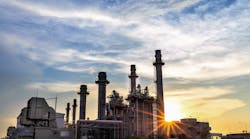The world market for continuous emissions monitoring systems (CEMS) for ambient and stack applications will exceed $1 billion/yr by 2012, according to a report by McIlvaine Company. This includes the analyzers, software and accompanying service revenues. McIlvaine predicts an additional $1 bill./yr. will be spent for intermittent stack sampling, with an even larger market for optimization systems that integrate the signals of emissions analyzers to meet regulatory requirements while maximizing process efficiency and minimizing lifecycle costs.
The biggest single market for CEMS is coal-fired boilers in Asia. McIlvaine says the large number of new plants in Asia will need stack monitoring systems to measure SO2, NOx, opacity, CO and O2. In addition, a number of Chinese plants are retrofitting SO2 and NOx reduction systems. This will require adding additional sets of monitors to existing stack systems.
U.S. cement plants are expected to spend over $60 million to upgrade their CEMS over the next two years. They will need to install analyzers to measure mercury, hydrocarbons, HCl and particulate. Cement plants in developing countries provide opportunities for the sale of opacity monitors. Coal-fired power plants in the U.S. have already spent over $200 million to measure mercury. Now with pending air toxic rules, they will need to measure HCl and organics. HCl monitors cost more than $100,000 each, so this market alone is expected to exceed $80 million.
In Europe as well as the United States there will be an expanding market for continuous emissions monitors to measure greenhouse gases including CO2 and methane. Fossil-fired power plants, cement kilns, and waste-to-energy plants will need to provide accurate measurement of these emissions.
The ambient market includes government networks needed to ascertain air quality throughout an area. The biggest markets for these systems will be in the developing countries. McIlvaine say there is also a need for fence-line monitoring at energy, mining and chemical facilities.
The market for stack and ambient intermittent sampling services is equal to the equipment market, according to McIlvaine. Some pollutants, such as SO2 and NOx, can be measured with a minimum of sophisticated equipment. However, mercury, toxic organics and some other pollutants require extensive equipment and considerable technical competence.
There is considerable potential for additional services to measure air toxics from major U.S. sources. These sources are required to report emissions of hundreds of individual pollutants annually, but there is no enforcement of precise measurement.
There are relatively few companies making the more technically advanced analyzers. ThermoFisher and Teledyne are examples of these companies. They tend to be international. Substantial research is required for each instrument developed. Expensive validation may be required in both the United States and Europe. This creates a barrier to entry for smaller competitors.
The stack sampling companies are generally smaller and have limited geographic scope. McIlvaine says thousands of these companies are competing for the smaller projects. Coal-fired power plants, waste-to-energy plants, and other large complex facilities require a number of testers for any project. As a result, there are relatively few testing companies competing for this business.

